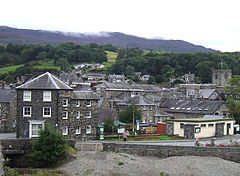Dolgellau
| Dolgellau | ||
|---|---|---|
| Cityscape | ||
| Coordinates | 52 ° 44 ′ N , 3 ° 53 ′ W | |
| OS National Grid | SH728178 | |
|
|
||
| Residents | 2678 (as of 2001) | |
| administration | ||
| Post town | DOLGELLAU | |
| ZIP code section | LL40 | |
| prefix | 01341 | |
| Part of the country | Wales | |
| Preserved County | Gwynedd | |
| Unitary authority | Gwynedd | |
| British Parliament | Meirionnydd Nant Conwy | |
| Welsh Parliament | Meirionnydd Nant Conwy | |
Dolgellau / dɔl'gɛɬaɨ̩ / is a small town in Wales ( United Kingdom ) in County Gwynedd at the confluence of the Mawddach and Wnion rivers .
history
Dolgellau lies at the foot of the Cadair Idris , on the southern edge of the Snowdonia National Park, founded in 1951 . Coin finds and other relics show that the Romans already settled here and mined for gold. Owain Glyndŵr held the last Welsh parliament here in 1404. The meeting house was demolished and rebuilt in a park in Newtown in 1885 .
In the 17th century, the region around Dolgellau developed into a center of the newly emerging Quaker movement , which was founded here in 1657. The farmer Rowland Ellis , a prominent local Quaker, emigrated to Pennsylvania with others in 1686 . The town of Bryn Mawr bears the name of his farm in Wales.
The current town has its origins in the 12th century. Most of the people who come to town cross the seven-arched bridge "Y Bont Fawr" (the great bridge) over the Wnion brook. It was originally built in 1638, but had to be extended for the railway line that ran through the city from 1868 to 1964 and restored in 1903 due to flood damage. The townscape of Dolgellau is defined by local granite and slate, and narrow, winding streets connect the different squares of the town. The Gothic church of St. Mary was built in 1716 on the foundations of a previous building from the 12th century.
Towards the end of the 19th century, Dolgellau was the district capital of Meirionnydd.
economy
As the regional center of sheep breeding, the city's development was closely linked to wool processing . This branch of business reached its peak around 1800, but quickly lost its outstanding economic importance with the introduction of mechanical looms . In times when production was flourishing, the wool was transported about 10 miles down the Wnion and then Mawddach to Barmouth Harbor . Even today, the annual “Wool Race” is a reminder of the former importance of this branch of industry.
Another important line of business in Dolgellau since 1800 was the printing industry. The city's first printing press went into operation in 1798.
In the middle of the 19th century, major gold discoveries were reported from the area. As a result, more than two dozen gold mines started operations; around 1900 they employed over 500 workers. The gold rush lasted only a short time, and by the 1920s most of the mines were falling into disrepair; the last gold mine was closed in 1935 after a devastating fire. In 1984 a mining operation resumed production on a trial basis.
tourism
The area around Dolgellau is scenically attractive and has been developed for tourists. Particularly impressive is the Cadair Idris massif in the south of the village with its five peaks; the highest point is the 892 m high Pen-y-Gadair. Idris is a legendary Welsh hero whose stories feature a magical chair ( Cadair ); whoever sleeps in it wakes up either a bard or a madman.
The Clywedog torrent flows into the Wnion near the town; a varied hiking trail, the so-called Torrent Walk , leads along this stream with its many small cascades and eddies.
Not far from Dolgellau are the ruins of Cymer Abbey , a Cistercian monastery founded in 1199 by Prince Gruffydd ap Cynan von Gwynedd and his brother, Prince Maredudd . The few that have survived include the 13th-century arcade of the church and three lancets in the east window, as well as a piece of the south wall with a piscina and remains of the cloister and refectory .
swell
- HE Conrad: Wales. Prestel Verlag, Munich 1982, ISBN 3-7913-0594-8 , p. 280.





